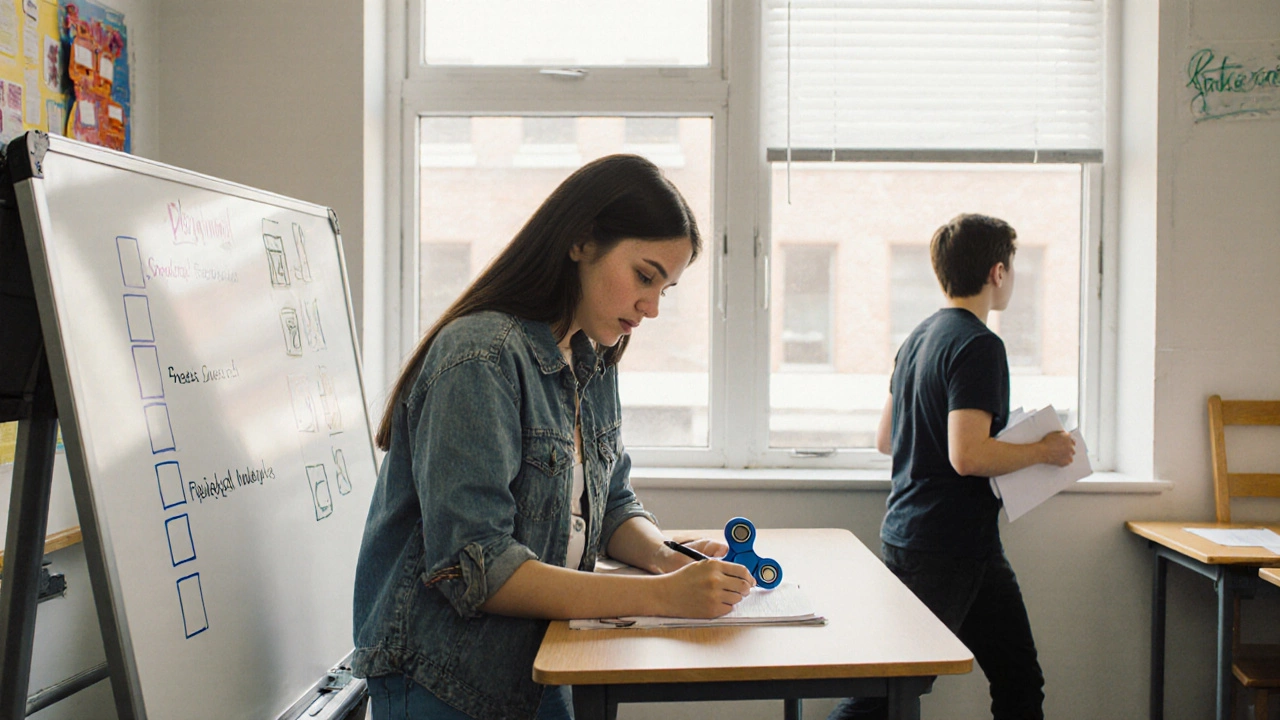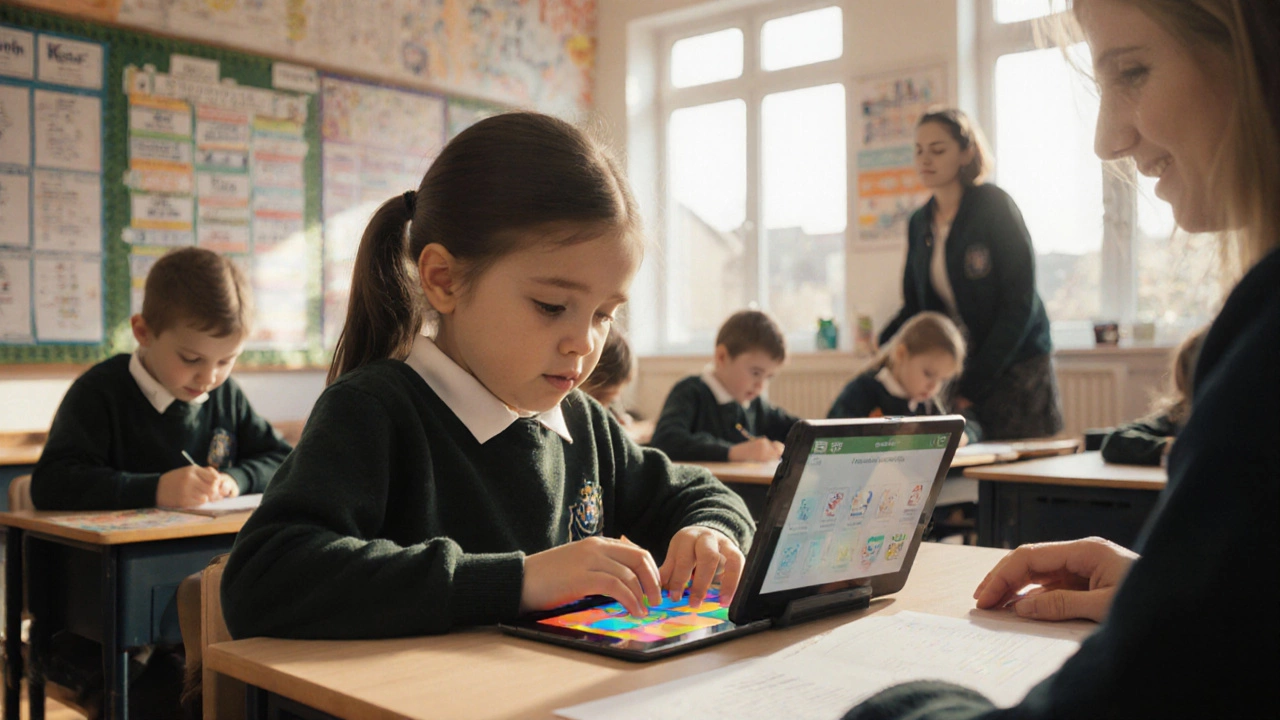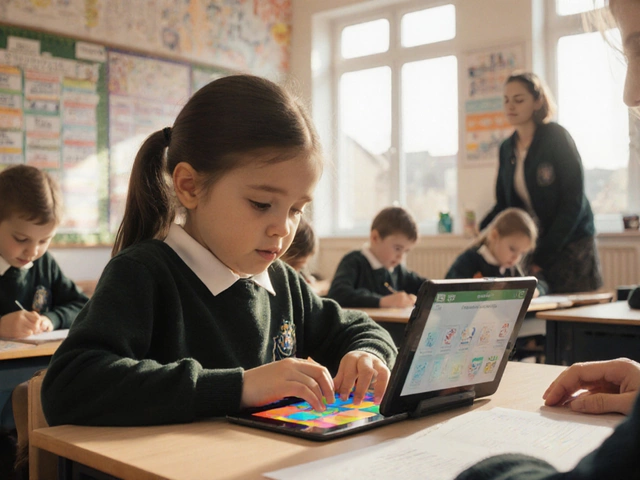Special Educational Needs Comparison Tool
Understand Common Special Needs
Compare key characteristics and effective support strategies for the most common special educational needs. Select a condition below to see specific information.
Select a condition to see detailed information
This tool compares common special educational needs and shows effective support strategies for each.
When you hear the term special educational needs, you might picture a classroom with extra help, specialized tools, or one-on-one support. But what exactly does that mean in real life? More than 1 in 5 students in the U.S. and U.K. receive some form of special education support. These aren’t rare cases-they’re everyday realities in schools around the world. Understanding the most common types helps parents, teachers, and caregivers step in earlier and more effectively.
Dyslexia: More Than Just Reversed Letters
Dyslexia is the most common learning disability, affecting up to 20% of the population. It’s not about seeing letters backward-that’s a myth. Real dyslexia is a brain-based difficulty with processing language. Kids with dyslexia struggle to connect sounds to letters, which makes reading slow and effortful. They might read "was" as "saw," or skip small words like "the" or "and."
It’s not a lack of intelligence. Many people with dyslexia are highly creative and think in pictures. But without the right support-like structured literacy programs such as Orton-Gillingham-they fall behind in every subject that relies on reading. By third grade, if dyslexia isn’t addressed, the gap widens. Early screening and phonics-based teaching make all the difference.
Autism Spectrum Disorder: A Wide Range of Experiences
Autism isn’t one thing. It’s a spectrum, and no two people experience it the same way. Some kids with autism speak fluently but struggle with social cues-like knowing when to take turns in conversation or reading facial expressions. Others may not speak at all and rely on communication devices. Repetitive behaviors, sensitivity to lights or sounds, and intense focus on specific topics are common.
Many schools now use visual schedules, social stories, and sensory breaks to help autistic students stay regulated. The key is flexibility. A child who thrives with a quiet corner and noise-canceling headphones might panic in a crowded cafeteria. Understanding each student’s unique profile-not just the label-is what works.
ADHD: It’s Not Just Being Distracted
Attention Deficit Hyperactivity Disorder (ADHD) shows up in three main ways: inattention, hyperactivity, or both. Kids with inattentive ADHD aren’t lazy-they’re overwhelmed by their brains filtering too much information at once. They forget homework, lose materials, and zone out during lectures. Those with hyperactive ADHD might fidget constantly, interrupt, or have trouble sitting still.
Medication helps some, but it’s not the only tool. Classroom strategies like breaking tasks into small steps, giving clear one-step instructions, and allowing movement breaks (like standing desks or walking to deliver papers) can dramatically improve focus. The goal isn’t to make them sit still-it’s to help them learn in ways that match how their brains work.
Speech and Language Disorders: When Words Don’t Come Easy
Speech disorders affect how a child produces sounds. Think lisping, omitting sounds, or sounding unclear even to family members. Language disorders are different-they’re about understanding or using words. A child might not know what "before" or "because" means, or struggle to form full sentences.
These issues often show up early. A 3-year-old who doesn’t combine two words, or a 5-year-old who can’t answer simple questions, might need speech therapy. Left unaddressed, these problems lead to frustration, behavioral issues, and reading delays. Speech-language pathologists don’t just teach pronunciation-they build vocabulary, teach grammar, and help kids express their thoughts clearly.

Developmental Coordination Disorder: The Silent Struggler
Also called dyspraxia, this condition affects motor skills. Kids with developmental coordination disorder aren’t clumsy because they’re not trying. Their brains have trouble sending the right signals to their muscles. They might tie shoes poorly, hold a pencil awkwardly, or trip over their own feet. Writing takes twice as long. Gym class is a nightmare.
They’re often labeled as "lazy" or "uncoordinated," but the issue is neurological. Occupational therapy helps build fine motor skills-like using scissors or buttoning shirts. Simple classroom adjustments, like extra time for writing, voice-to-text tools, or allowing typed assignments, can remove barriers that have nothing to do with intelligence.
Intellectual Disability: Understanding Cognitive Differences
An intellectual disability means a person learns more slowly than peers and has trouble with reasoning, problem-solving, and daily living skills. It’s not a disease-it’s a difference in how the brain processes information. IQ scores below 70 are one marker, but real-life functioning matters more. Can the child dress themselves? Follow a routine? Understand safety rules?
Support isn’t about lowering expectations-it’s about changing how skills are taught. Visual aids, repetition, hands-on learning, and real-life practice (like counting money or reading a bus schedule) build independence. Many kids with intellectual disabilities thrive in inclusive classrooms with peer support and individualized goals.
Emotional and Behavioral Disorders: When Feelings Overwhelm
Some children struggle with anxiety, depression, or oppositional behavior that interferes with learning. This isn’t just acting out. It’s often a response to trauma, untreated mental health conditions, or sensory overload. A child who throws things, refuses to speak, or shuts down during tests may not be "bad"-they’re overwhelmed.
Traditional discipline doesn’t work here. Instead, trauma-informed schools use de-escalation techniques, safe spaces, and social-emotional learning programs. Building trust matters more than compliance. A child who feels safe is far more likely to learn.

Other Conditions: Hearing Loss, Visual Impairments, and Medical Needs
Not all special needs are learning-based. Children with hearing loss need sign language interpreters or FM systems. Those with visual impairments use braille, screen readers, or tactile diagrams. Kids with epilepsy, diabetes, or severe allergies require trained staff and emergency plans.
These needs are often overlooked in general discussions about special education. But they’re just as valid. A child who can’t hear the teacher won’t learn, no matter how smart they are. The same goes for a child who can’t see the board. Accommodations aren’t favors-they’re necessities.
Why Early Identification Matters
Every child with special needs deserves to be seen for who they are-not just their diagnosis. But the longer a problem goes unnoticed, the harder it is to fix. A child who falls behind in reading by second grade rarely catches up without intensive help. A child who’s labeled "disruptive" without understanding the cause starts to believe they’re broken.
Screening tools, teacher training, and parent partnerships are the first lines of defense. Schools that use universal screening for reading, speech, and behavior catch problems early. Parents who notice delays in speech, motor skills, or social interaction should speak up. You don’t need a formal diagnosis to ask for help.
What Support Looks Like in Practice
Support isn’t one-size-fits-all. A child with dyslexia might need audiobooks and speech-to-text software. A child with autism might need a visual timer and a quiet space to reset. A child with ADHD might benefit from movement breaks and checklists.
Most schools offer Individualized Education Programs (IEPs) or 504 Plans. These are legal documents that spell out exactly what support the child gets-extra time, modified assignments, therapy services, or assistive tech. Parents have a right to be part of those decisions. Don’t wait for the school to come to you. Ask questions. Request evaluations. Push for data, not just opinions.
It’s Not About Fixing the Child
The biggest mistake is thinking special education is about fixing kids. It’s not. It’s about fixing the system. A child with dyslexia doesn’t need to be "cured." They need the right tools to read. A child with ADHD doesn’t need to sit still-they need to move. A child with autism doesn’t need to act "normal"-they need to feel safe.
When schools focus on accessibility instead of conformity, everyone wins. Classrooms become more flexible, creative, and inclusive. Other students learn empathy. Teachers become better educators. And children with special needs? They finally get to learn-not just survive.








Write a comment